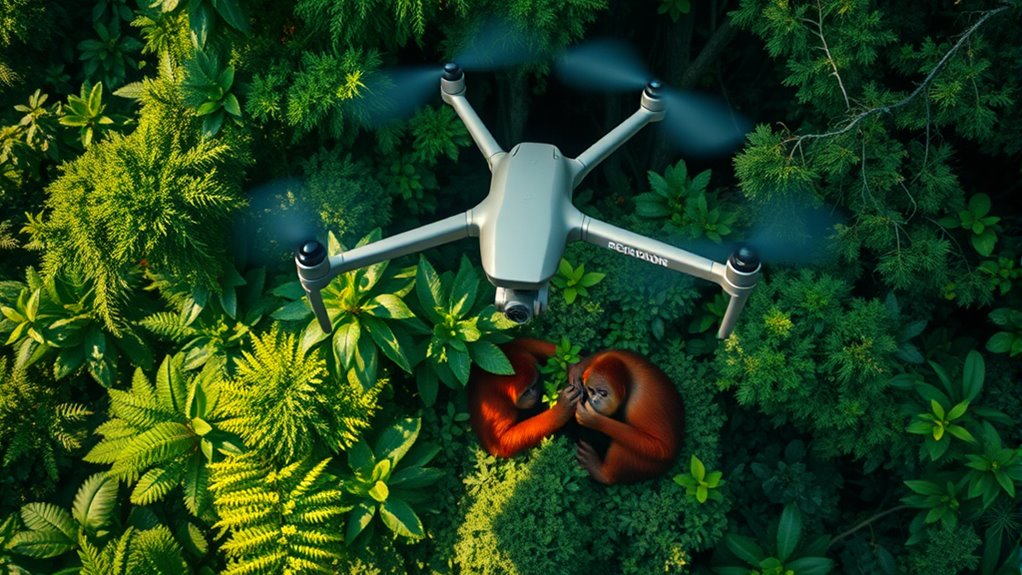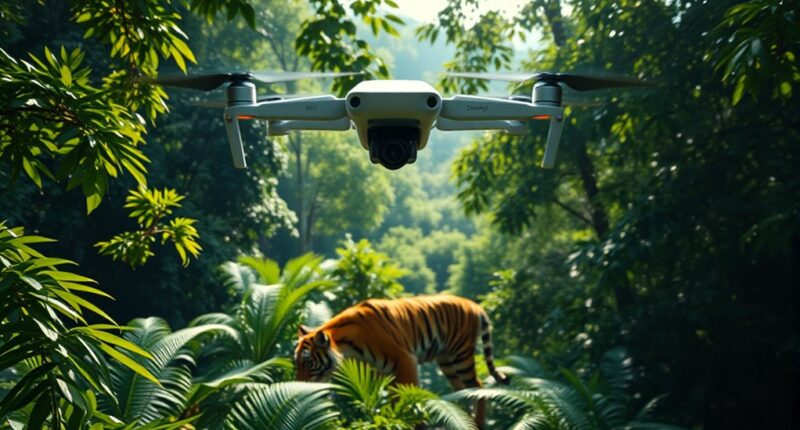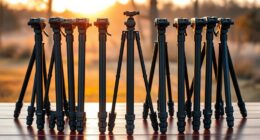Conservation drones act as “eyes in the sky,” helping you protect endangered species more effectively. They allow you to monitor wildlife and habitats in real time, even in remote or difficult terrains, reducing the need for risky human patrols. With high-resolution sensors and autonomous capabilities, drones provide quick, detailed data on animal movements, threats like poaching, and habitat changes. Keep exploring to discover how these innovative tools are transforming conservation efforts worldwide.
Key Takeaways
- Drones provide real-time, high-resolution imagery to monitor and protect endangered species effectively.
- They access remote, difficult terrains to track elusive or nocturnal animals without disturbance.
- Equipped with sensors and thermal cameras, drones help detect threats like poaching and habitat loss early.
- Autonomous drone operations with AI enable rapid data analysis, supporting proactive conservation measures.
- Cost-effective and safer, drones enhance habitat monitoring and wildlife tracking to prevent extinction risks.

Have you ever wondered how technology is transforming wildlife conservation? Drones are at the forefront of this revolution, providing innovative ways to protect endangered species and their habitats. These flying tools serve as powerful eyes in the sky, giving conservationists real-time data that was once nearly impossible to gather. With their ability to access remote or difficult terrain, drones enable more effective wildlife tracking and habitat monitoring, making it easier to detect threats and respond swiftly.
Wildlife tracking is one of the most critical applications of conservation drones. By deploying these devices, you can monitor animal movements without disturbing them. Drones equipped with thermal cameras or high-resolution sensors can follow elusive or nocturnal animals, giving you insights into their behavior, migration patterns, and population numbers. This data helps identify critical areas that need protection and allows for targeted interventions to prevent poaching or habitat destruction. The advantage of using drones is their agility and ability to cover large areas quickly, providing a thorough picture of wildlife activity that ground surveys often miss.
Habitat monitoring is another essential aspect where drones excel. You can use them to survey vast landscapes and detect changes in vegetation, water sources, or land use. This is especially useful in remote or inaccessible regions where traditional monitoring might be limited or dangerous. With frequent drone flights, you keep a close eye on habitat health, spotting signs of degradation or encroachment early enough to take corrective measures. This proactive approach helps maintain ecological balance and ensures endangered species have a safe environment to thrive.
The integration of wildlife tracking and habitat monitoring through drones not only enhances your ability to gather data but also reduces human risk and costs. Instead of deploying teams on foot into risky terrains, you can rely on drones to do the heavy lifting, collecting high-quality data efficiently. Plus, the real-time transmission of imagery and sensor readings allows you to make swift, informed decisions. As technology advances, these drones are becoming more autonomous, with sophisticated AI analyzing data instantly, which means quicker responses to threats like illegal poaching or habitat destruction.
Adding to these benefits, the development of lightweight and durable drone designs based on Balance Bikes and Scooters principles allows for longer flight times and easier handling, making continuous monitoring more feasible and cost-effective.
Frequently Asked Questions
How Do Drones Impact Local Wildlife Behavior?
When you use drones, you might cause wildlife disturbance and habitat disruption. Animals can become scared or stressed when they see or hear drones nearby, leading to altered behaviors like fleeing or hiding. This disruption can disturb their natural routines and habitat use. To minimize impact, you should fly drones carefully, keep a safe distance, and avoid sensitive areas, ensuring wildlife remains undisturbed while still gathering important conservation data.
What Are the Ethical Considerations of Using Surveillance Drones?
You should consider that 70% of people worry about privacy concerns with surveillance drones. When using them, you must address ethical issues like respecting privacy and ensuring data security. It’s essential to balance the benefits of monitoring, such as protecting wildlife, with the risks of intrusive surveillance. By implementing strict data security measures and transparent policies, you can help mitigate ethical concerns and foster trust in drone use.
How Cost-Effective Are Conservation Drones Compared to Traditional Methods?
You might wonder how conservation drones compare financially to traditional methods. When you do a cost analysis, drones often prove more cost-effective over time, especially as they require less manpower and reduce travel expenses. Funding sources can also be more accessible for drone projects, making them a smart investment. Overall, using drones can save money while providing better monitoring, making them a practical choice for conservation efforts.
Can Drones Operate in Extreme Weather Conditions?
Imagine a sturdy boat sailing through stormy seas—your drone must do the same. While some drones boast weather resilience and advanced drone durability, extreme weather conditions like heavy rain, snow, or high winds challenge their operation. Not all drones are built for such environments, so you need specialized models designed to withstand harsh conditions. With the right technology, you can guarantee your drone remains effective even amidst nature’s fiercest tests.
What Training Is Required for Drone Operators in Conservation Efforts?
You need specialized training to become a drone operator for conservation efforts. This includes learning about wildlife monitoring techniques and obtaining pilot certification to guarantee safe, effective flights. You’ll also learn how to handle equipment in various conditions, interpret data accurately, and follow legal regulations. Proper training helps you contribute meaningfully to saving endangered species, making your role essential in conservation projects.
Conclusion
As you see, conservation drones are like vigilant guardians soaring above, tirelessly watching over endangered species. They’re transforming how we protect our planet’s most precious creatures, turning the sky into a guardian’s eye. With each flight, you’re helping paint a brighter future—one where technology and nature work hand in hand. These drones are the silent heroes, lifting the weight of conservation and giving hope wings to soar. Together, you’re making a difference that echoes beyond the clouds.










